Creating a macOS bootable USB drive using a Windows 11 PC can be a lifesaver when your Mac encounters issues that prevent it from starting up properly. This guide provides detailed instructions to help you build a bootable USB drive, allowing you to restore or reinstall macOS on your unresponsive Mac.
To get started, you'll need the following:
- A USB drive with at least 16 GB of storage capacity.
- A macOS
.dmgfile.
If you don't have a macOS .dmg file, you can download older versions from the Apple website at support.apple.com. Be cautious when obtaining newer versions from third-party sources, as they may contain malware or violate legal guidelines. It's best to use official channels whenever possible.
Downloading the macOS DMG file
Step 1: Open your preferred web browser and navigate to support.apple.com/en-in/HT211683.
Step 2: Scroll down to find the list of available macOS versions. Right-click on the version you need and select 'Save as' to download the .dmg file to your desired location.
Preparing the USB drive for macOS
Before you can create the bootable USB, you need to format the USB drive and set up the correct partition scheme.
Step 1: Insert the USB drive into your Windows 11 computer and ensure it is detected.
Step 2: Click on the Start Menu, type Terminal, and search for the application. Right-click on 'Terminal' and select 'Run as administrator'.

Step 3: In the Terminal window, click the downward arrow icon and choose 'Command Prompt' from the menu.

Step 4: Type diskpart and press Enter to launch the DiskPart utility.

Step 5: Enter the command list disk and press Enter to view all connected disks.

Step 6: Identify your USB drive from the list by its size (e.g., it might appear as Disk 1 if it's around 16 GB).
Step 7: Type select disk 1 (replace '1' with the number corresponding to your USB drive) and press Enter.

Step 8: Enter clean and press Enter to remove all data and partitions from the USB drive.

Step 9: Type convert GPT and press Enter to convert the disk to the GPT partition scheme.

Step 10: Input create partition primary and press Enter to create a new primary partition on the USB drive.

Now that your USB drive is properly formatted and partitioned, you're ready to transfer the macOS .dmg file onto it.
Creating a bootable macOS USB
To write the macOS .dmg file to your USB drive, you'll use TransMac, a utility that enables Windows to read and write macOS-formatted drives.
Step 1: Download TransMac by visiting acutesystems.com/scrtm.htm and clicking on the 'tmsetup.zip' link.

Step 2: Navigate to your 'Downloads' folder and extract the 'tmsetup.zip' file. Double-click 'setup.exe' to start the installation process.

Step 3: Follow the installation prompts by clicking 'Next'. Accept the license agreement, and choose the default installation location unless you prefer a different directory.

Step 4: Complete the installation by clicking 'Finish' once the process is done.

Step 5: Open TransMac by double-clicking the desktop icon.

Step 6: Click 'Run' to use the 15-day trial version of TransMac.

Step 7: In TransMac, right-click your USB drive listed in the left pane and select 'Format Disk for Mac'. Confirm by clicking 'Yes'.

Step 8: When prompted, enter a name for your USB drive (e.g., "macOS_Bootable") and click 'OK'. Acknowledge any warnings by clicking 'Yes'.

Step 9: After formatting is complete, right-click the USB drive again and choose 'Restore with Disk Image'. Confirm the action by clicking 'Yes'.

Step 10: In the dialog box, click the ellipsis (...) button to browse for your macOS .dmg file. Select the file and click 'Open', then click 'Yes' to begin writing the disk image to the USB drive.

Please wait while TransMac transfers the macOS .dmg file to your USB drive. This process may take some time depending on the size of the file and the speed of your USB drive.
Booting your Mac with the newly created macOS bootable USB
Step 1: Safely eject the USB drive from your Windows 11 computer.
Step 2: Insert the bootable USB drive into your Mac's USB port.
Step 3: Turn on your Mac while holding down the Option key on your keyboard.
Step 4: When the Startup Manager appears, select the macOS bootable USB drive to begin the macOS installation or recovery process.
By following these detailed steps, you can successfully create a macOS bootable USB drive using a Windows 11 PC. This tool can be invaluable for restoring your Mac if it becomes unresponsive or encounters startup issues.











Member discussion